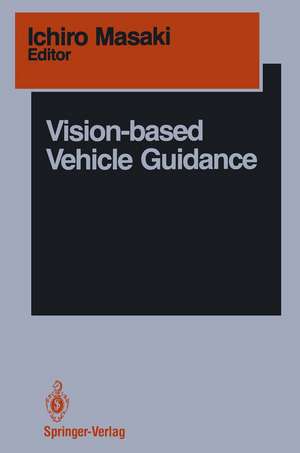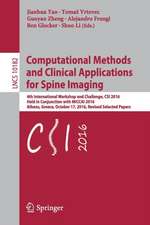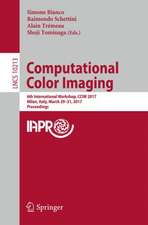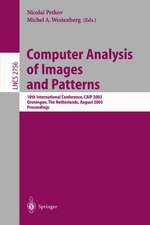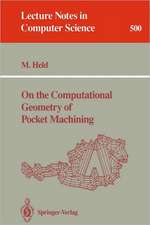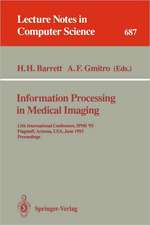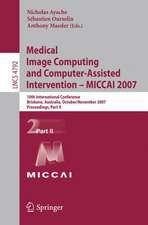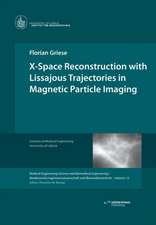Vision-based Vehicle Guidance: Springer Series in Perception Engineering
Editat de Ichiro Masakien Limba Engleză Paperback – 26 sep 2011
Preț: 335.52 lei
Preț vechi: 419.39 lei
-20% Nou
Puncte Express: 503
Preț estimativ în valută:
64.22€ • 69.78$ • 53.98£
64.22€ • 69.78$ • 53.98£
Carte tipărită la comandă
Livrare economică 21 aprilie-05 mai
Preluare comenzi: 021 569.72.76
Specificații
ISBN-13: 9781461276654
ISBN-10: 1461276659
Pagini: 360
Ilustrații: XVIII, 332 p.
Dimensiuni: 155 x 235 x 19 mm
Greutate: 0.5 kg
Ediția:Softcover reprint of the original 1st ed. 1992
Editura: Springer
Colecția Springer
Seria Springer Series in Perception Engineering
Locul publicării:New York, NY, United States
ISBN-10: 1461276659
Pagini: 360
Ilustrații: XVIII, 332 p.
Dimensiuni: 155 x 235 x 19 mm
Greutate: 0.5 kg
Ediția:Softcover reprint of the original 1st ed. 1992
Editura: Springer
Colecția Springer
Seria Springer Series in Perception Engineering
Locul publicării:New York, NY, United States
Public țintă
ResearchCuprins
1 Vision-based Autonomous Road Vehicles.- 1.1 Abstract.- 1.2 Introduction.- 1.3 Some Experimental Autonomous Road Vehicles.- 1.4 Future Developments.- 1.5 Applications.- 1.6 Conclusions.- References.- 2 The New Generation System for the CMU Navlab.- 2.1 Abstract.- 2.2 Introduction.- 2.3 Color Vision for Road Following.- 2.4 3-D Perception.- 2.5 Planning.- 2.6 Architectures.- 2.7 Maps and Missions.- 2.8 Contributions, Lessons, and Conclusions.- References.- 3 Algorithms for Road Navigation.- 3.1 Introduction.- 3.2 Maryland Road Follower.- 3.3 Recovery of Three-Dimensional Road Geometry.- 3.4 Detection of Stationary Obstacles on Roads.- 3.5 Conclusion.- References.- 4 A Visual Control System Using Image Processing and Fuzzy Theory.- 4.1 Abstract.- 4.2 Introduction.- 4.3 Development of the System.- 4.4 Developed System.- 4.5 Experiment.- 4.6 Conclusion.- 4.7 Further Study.- References.- 5 Local Processing as a Cue for Decreasing 3-D Structure Computation.- 5.1 Abstract.- 5.2 Introduction.- 5.3 Active Vision.- 5.4 Tracking.- 5.5 Conclusion.- References.- 6 Object Detection Using Model-based Prediction and Motion Parallax.- 6.1 Motion Parallax and Object Background Separation.- 6.2 Image Transformation for Motion Relative to a Planar Surface.- 6.3 Estimation of Parameters by Minimization of Prediction Error.- 6.4 Sequential Estimation Using Recorded Sequence.- 6.5 Object Detection Using Prediction Error.- 6.6 Experimental Results and Conclusions.- References.- 7 Road Sign Recognition: A Study of Vision-based Decision Making for Road Environment Recognition.- 7.1 Abstract.- 7.2 Introduction.- 7.3 Technology and Car Equipment.- 7.4 Vision Algorithm.- 7.5 Decision Making.- 7.6 Performances and Conclusions.- References.- 8 From Self-Navigation to Driver’s Associate: AnApplication of Mobile Robot Vision to a Vehicle Information System.- 8.1 Abstract.- 8.2 Introductory Remarks.- 8.3 The Concept of Driver’s Associate.- 8.4 An Environment Identification Problem.- 8.5 Image Feature Extraction and Segmentation.- 8.6 Frustration Resolution Schemes for Top-Down Processing.- 8.7 2-D Syntax Analysis for Bottom-Up Processing.- 8.8 Hardware Structure.- 8.9 Dynamic Image Analysis Mechanism.- 8.10 Basic Operation Scenario.- 8.11 Discussion.- 8.12 Concluding Remarks.- References.- 9 Recent Progress in Mobile Robot Harunobu-4.- 9.1 Introduction.- 9.2 Visuomotor System in a Mobile Robot.- 9.3 Active Sensing in Stereotyped Motion.- 9.4 Shadow Elimination.- 9.5 Concluding Remarks.- References.- 10 Visual Navigation of an Autonomous On-Road Vehicle: Autonomous Cruising on Highways.- 10.1 Abstract.- 10.2 Introduction.- 10.3 Vehicle Autonomy.- 10.4 Framework of the Autonomous Control System.- 10.5 Autonomous Cruise Simulation.- 10.6 Visual Navigation Experiment.- References.- 11 Finding Road Lane Boundaries for Vision-guided Vehicle Navigation.- 11.1 Abstract.- 11.2 Introduction.- 11.3 Road Model.- 11.4 Transformation between Image and Real-World Coordinates.- 11.5 Extraction of White Lane Markings.- 11.6 Fitting Lane Boundaries to the Lane Markings.- 11.7 Grouping the Lane Boundaries into Road Lanes.- 11.8 Experimental Results.- 11.9 Conclusions.- References.- 12 An Extracting Method of the Optical Flow for an Anticollision System.- 12.1 Abstract.- 12.2 Introduction.- 12.3 A Gradient Method.- 12.4 A Calculation Algorithm.- 12.5 Calculation Results.- 12.6 Discussion.- 12.7 Conclusion.- References.- 13 Obstacle Avoidance and Trajectory Planning for an Indoor Mobile Robot Using Stereo Vision and Delaunay Triangulation.- 13.1 Abstract.- 13.2Introduction.- 13.3 What Do We Do with the 3-D Wire Frames?.- 13.4 Two-Dimensional Map Simplification.- 13.5 Constructing a Volume Representation of Free Space.- 13.6 Results.- 13.7 Conclusions.- References.- 14 A Parallel Architecture for Curvature-based Road Scene Classification.- 14.1 Abstract.- 14.2 Introduction.- 14.3 System Outline.- 14.4 Parallel Implementation of System Algorithms.- 14.5 Implementation Results.- 14.6 Directions for Future Research.- 14.7 Conclusion.- References.- 15 Mobile Robot Perception Using Vertical Line Stereo.- 15.1 Abstract.- 15.2 Introduction.- 15.3 Detecting and Linking Vertical Edges.- 15.4 Measuring Image Flow by Tracking Edge Segments.- 15.5 Correspondence Matching Using Dynamic Programming.- 15.6 Recovery of 3-D Position from Stereo Information.- 15.7 Generating 3-D Vertical Segments in Scene Coordinates.- 15.8 Conclusions and Perspectives.- References.
